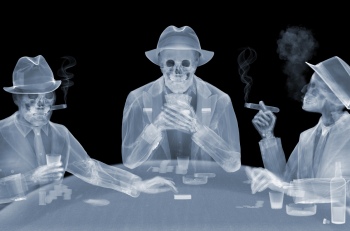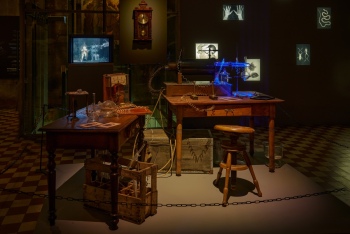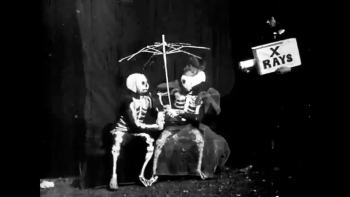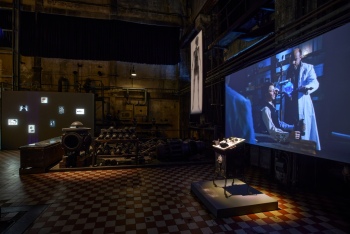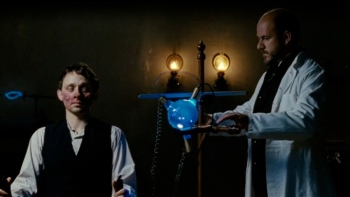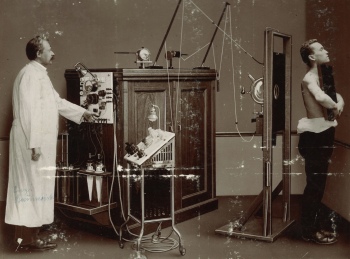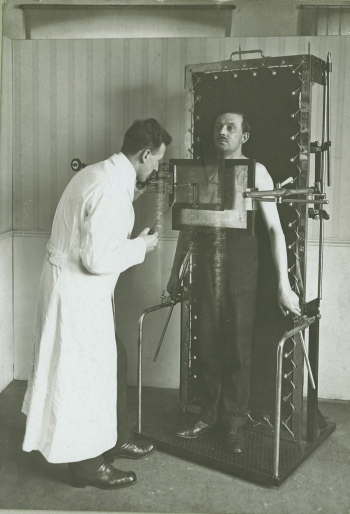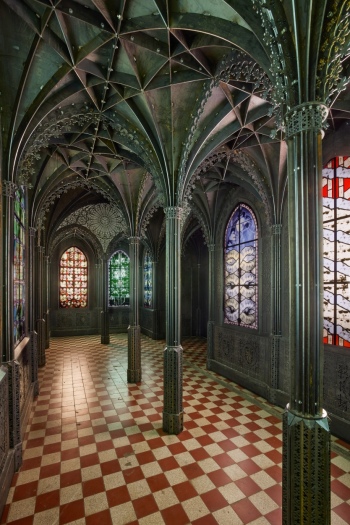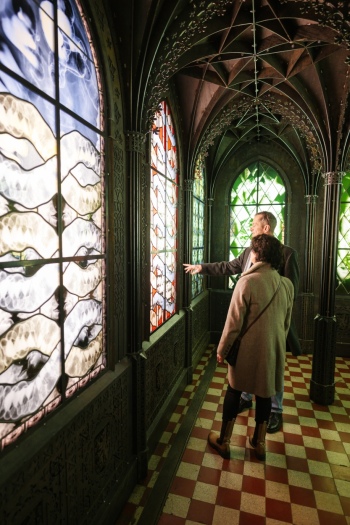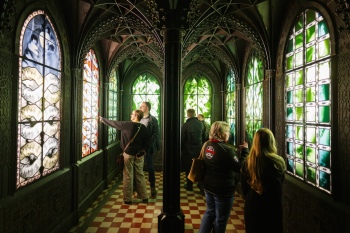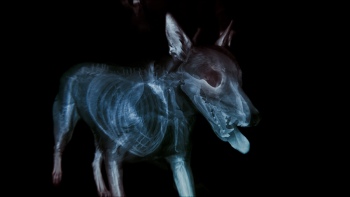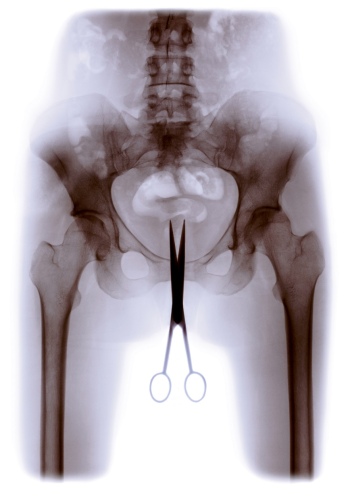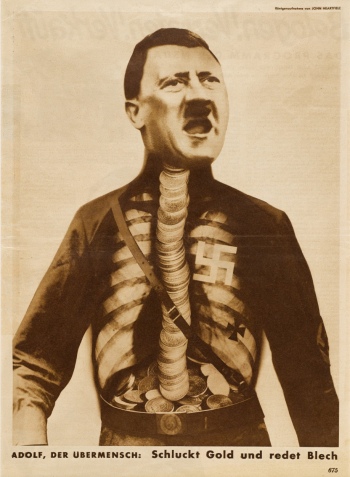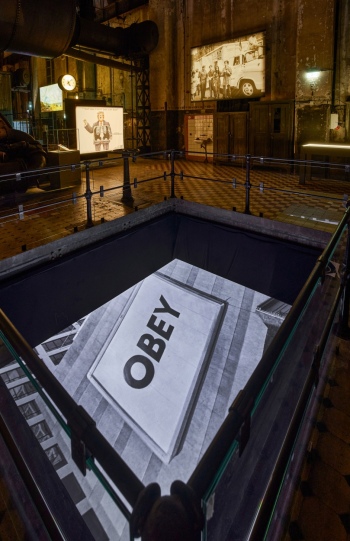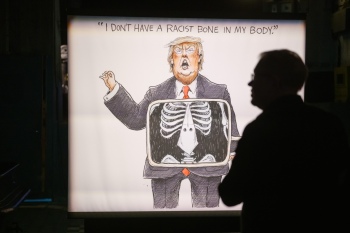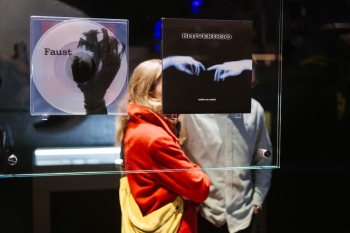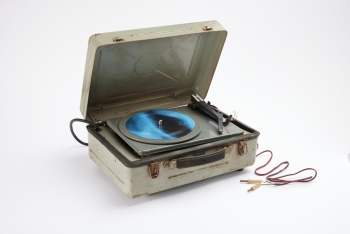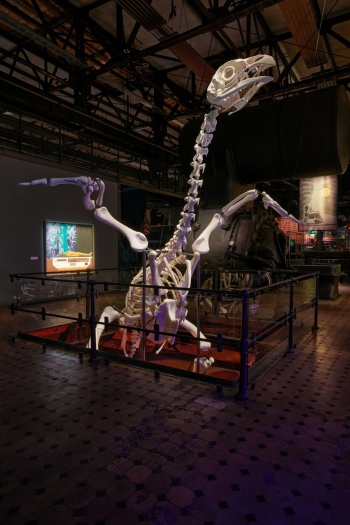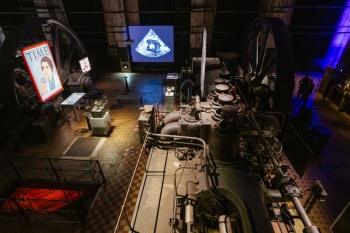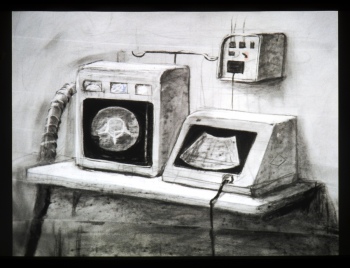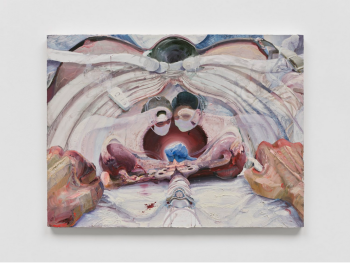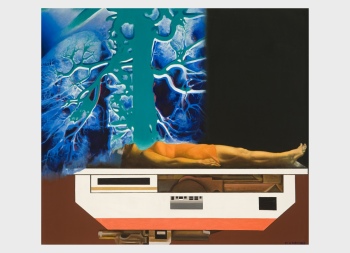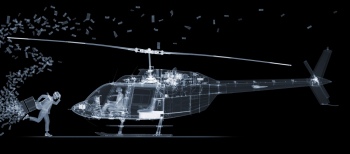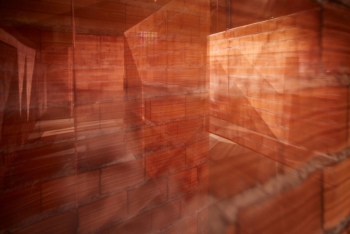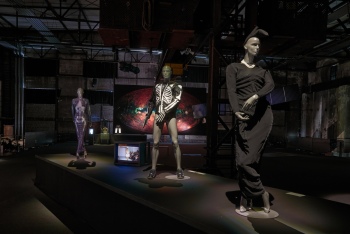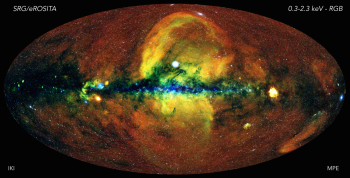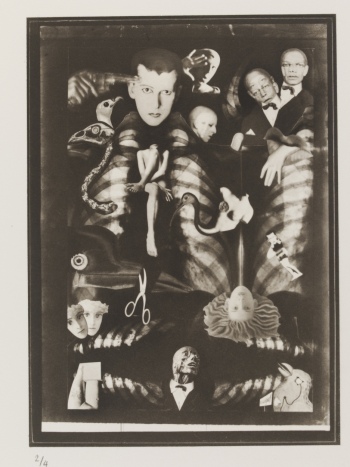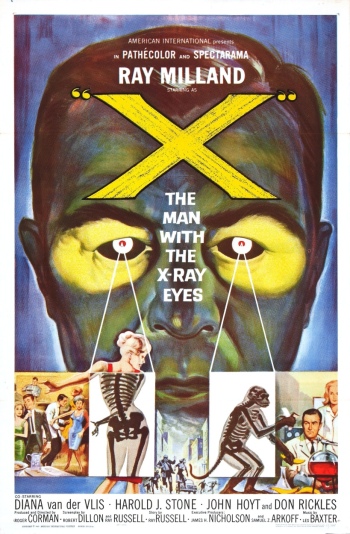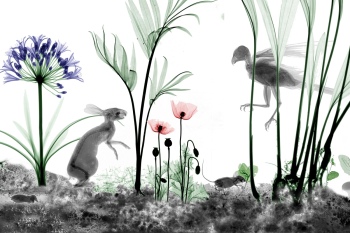X-RAY
X-RAY
X-RAY
The Power of Roentgen Vision
Blower hall and Compression hall, World Heritage Site Völklinger Hütte 9 November 2025–16 August 2026
X-RAY is the first exhibition ever to comprehensively dedicate itself to the phenomenon of X-rays and the numerous cultural and artistic aspects of the X-ray vision. Based on the wide spectrum of X-ray technology – from the very first X-ray image to historic X-ray devices in medicine and the natural sciences, and up to the latest X-ray satellite in space research – the exhibition particularly highlights the creative interplay of the X-ray gaze in art and cultural history, politics, nature, literature and architecture, music, fashion, and cinema.
On November 8, 2025, it will be exactly 130 years since Wilhelm Conrad Röntgen first consciously perceived X-rays in his Würzburg laboratory as a previously unknown phenomenon. Only a few weeks later, this groundbreaking discovery spread like wildfire around the globe, inspiring not only scientists but also visual artists, musicians, filmmakers, and cartoonists.
This fascination remains unbroken to this day, as demonstrated by the X-RAY experience parcours: In the industrial cathedral of the Blower Hall, it unites an X-ray chapel by Wim Delvoye as well as a transparent brick labyrinth by Cris Bierrenbach, a catwalk featuring X-ray fashion, and a cinema for X-RAY films. Across 18 chapters, a striking panorama of modernity and the present unfolds: Here, Marie Curie encounters Claude Cahun, Frida Kahlo, Isa Genzken, and Iris van Herpen; John Heartfield meets Edvard Munch, Mies van der Rohe, Thomas Mann, and William Wegman. X-RAY makes the invisible visible – turning art and science into a tangible experience.
“X-rays permeate our modernity and present in an utterly unique way: Thanks to them we experience medicine, politics, history, art, and nature differently – even concepts like gender roles are redefined. We literally glimpse at otherwise hidden layers of ourselves and our environment – from the molecules and codes of our bodies, to the most distant galaxies of outer space,” says curator Dr. Ralf Beil.
HISTORY AND PRESENT OF X-RAYS
Following Wilhelm Conrad Röntgen’s discovery of X-rays in November 1895, news of this novel type of radiation and its ability to penetrate the invisible realm spread like wildfire, unleashing a storm of enthusiasm among physicists, doctors and the general public. After his discovery on 8 November 1895, Wilhelm Conrad Röntgen sent off special prints in five languages with a detailed description of his experimental setup, so that countless laboratories with the same equipment, from Buenos Aires to Vienna, St. Petersburg, Calcutta and Melbourne, were able to repeat the production of the rays and images of X-rayed objects. Yet he relinquished any claim to patent rights, a decision that fuelled the spread of this seemingly magical form of radiation – and surely played a role in him being awarded in 1901 the first ever Nobel Prize in Physics.
The discovery of X-rays is the spectacular culmination of a quest to discover the realm of the invisible in the late 19th century. Speculative forays over preceding decades indicate a widespread fascination with this topic. A story by Kurd Laßwitz, for example, the father of German science fiction, tells of a private researcher who develops a substance called “Diaphot” that renders the body transparent. Similarly, the novel Elektra, published by Ludwig Hopf in 1892 under the pseudonym of Philander, features a country doctor and his celebrated wish: “If only there were a way to make people as transparent as jellyfish!”
It was in 1895, the year of Röntgen’s discovery, that Sigmund Freud coined the word “psychoanalysis” to describe the method by which he would plumb the realm of dreams and the unconscious. That same year, the first ever commercial film was screened in Berlin using the Bioscope format. Soon after, G. A. Smith’s short film The X-Rays (1897) made playful use of this magical form of radiation in a story of two lovers. Around the same time, microbiology discovered a hitherto unknown “life form”: the virus. From the very beginning, Eros, Thanatos, and Techne (Ancient Greek for art, skill, craft) were all inextricably linked with X-ray vision.
X-RAY showcases a broad spectrum of X-ray technologies and its many applications, including early laboratory apparatus and X-ray images, the Pedoscope shoe-fitting machine (introduced around 1920), and X-ray satellites such as eROSITA, which are used to explore galaxies and investigate dark matter in space.
The central theme of the exhibition is the transillumination – whether close-up or from afar – of animate and inanimate matter. Exhibits include the “Transparent Human”, which was created at the end of the 1920s by the Deutsches Hygiene-Museum in Dresden. This iconic representation of X-ray vision provides a view of the complex structures within the human body.
The imaging techniques of X-ray technology have continuously improved – culminating in computed tomography (CT), which allows the generation of three-dimensional data. During examinations, radiation exposure, which used to be massive and hazardous to health, is now kept as low as possible. While radiology has become an ever-evolving routine, cultural actors remain fascinated by the phenomenon of X-rays in various ways up to the present day.
The creative means employed in such works include original X-ray images, which are cropped, painted over, or modified, augmented and collaged with different materials and colours; digitally enlarged images that serve as templates for glass windows; and graphic simulations of the X-ray process. Similarly, radiological motifs are incorporated in paintings, sculptures and graphics. And skull X-rays feature as a motif in the vanitas genre along with skeletons and individual bones, both continuing in idiosyncratic fashion a long tradition of memento mori and danse macabre.
Used as a medium in the visual arts, X-ray images depart from a traditional, mimetic, realistic reproduction of reality. Instead, they deal in alienation, depriving their object of its three-dimensional spatiality, replacing it with a shadowy silhouette, and adding metaphorical depth by revealing hidden structures and the invisible. This medium, developed at the threshold of the 20th century, has therefore become a hallmark of both modern and contemporary art.
When artists begin, starting with Meret Oppenheim, to present skull X-rays as self-portrait, the renunciation of the familiar human image is complete. Beneath the surface, an entirely different individual (or precisely beyond-individual) identity reveals itself. Beyond the visual arts, a radiological aesthetic has left its impact on architecture, fashion, advertising, caricature and comics.
X-ray images and the associated X-ray gaze appear as citations permeating life and everyday routines in literature and sometimes even become agents of action in film and television.
THE EXHIBITION ROUTE
The exhibition route of X-RAY is staged as an experiential landscape and gathers in the midst of the historic blower machines, among other things, an early X-ray laboratory, a walk-in X-ray chapel by Wim Delvoye, a round-arch stained glass window made from lung X-ray images by Christoph Brech, a dinosaur-sized broiler chicken skeleton by Andreas Greiner, a transparent brick labyrinth by Cris Bierrenbach, a catwalk with X-RAY fashion by Elsa Schiaparelli, Jean Paul Gaultier, and Iris van Herpen, a satellite model at a scale of 1:1.15 in the airspace of the blower hall, as well as Rosie Leventon's ship made of X-ray images and an X-RAY cinema in the compression hall. The exhibition aims to reach the broadest possible audience by connecting the wide spectrum from science to every conceivable art form with insights that are both captivating and knowledgeable.
A BRIEF OVERVIEW OF THE EXHIBITION CHAPTERS
The exhibition begins with an introduction to the topic from a historical and physical viewpoint. The quest to reveal the invisible realm is illustrated by works from Leonardo da Vinci and a sequence of images especially created for the show by graphic novel author Jens Harder. This is followed by a presentation of the early days of X-ray research, around the year 1900, with a recreation of Wilhelm Conrad Röntgen’s laboratory. Whether in early film, music or caricature, Röntgen’s decision to afford open access to his discovery triggered a worldwide wave of enthusiasm for X-rays that would culminate in him being awarded the first ever Nobel Prize in Physics. Nevertheless, soon the dangers of X-ray radiation, alongside the opportunities, come into view.
A section on radiology during the First World War highlights the significant role played by two-time Nobel Prize-winner Marie Curie in advancing the use of X-ray technology. In the 1920s, the “Transparent Human” in Dresden showcased this hitherto unknown transparency of the human body. The illumination of the body is mirrored, following Freud, in the illumination of the soul through art and literature, notably in the works of Thomas Mann, Frida Kahlo, and Edvard Munch.
After this chronological introduction, the following chapters address their topics diachronically through the 20th century to the present day. Transcendence, religion, and breaking taboos meet gender roles and body images. The focal point here is the 10 x 5 meter visitor-accessible chapel by Wim Delvoye, on loan from Mudam Luxembourg.
A key chapter is dedicated to politics. This brings together political caricatures incorporating X-ray vision, documents of civil courage, and testimonies of subjection and violence. The Third Reich and the GDR are as present here as the USA, Chile, and colonial as well as postcolonial South Africa. The transition to music occurs seamlessly with the political subversion of bootlegged Western music on X-ray images in the states of the Soviet Union, followed by a music video and record display full of radiologically inspired creativity.
Expeditions into the deep layers of art follow. On five large screens, visitors can literally delve into paintings by Goya or van Gogh using digital glasses and sliders. Next come the explorations of the animal world, medicine, and molecular biology. The actuality and severity of the lung disease tuberculosis are powerfully illustrated with the example of the film and photographic documentation by Maxim Dondyuk from Ukraine.
Up to 10-meter-long panoramas of nature and technology frame the large playing area, which features the chapter on architecture and a walkable labyrinth made of transparent brick walls, as well as a catwalk showcasing X-ray fashion. On and above the front wall of the large stage area, the remapping of space becomes an experience: X-ray telescopes enable the exploration of black holes and dark matter in the galaxies of outer space through the detection of captured X-ray radiation.
In the compression hall, selected works of art from modern and contemporary periods address the major thematic complex of identity, death, and eternity, while the cinema hall of the compression hall showcases the most powerful films related to X-RAY. The intensity of the X-ray gaze is evidenced not only by film posters in and on the historic cinema ticket booth but also by a selection of Supergirl and Superman comics.
THREE SELECTED X-RAY INSTALLATIONS
Andreas Greiner, MONUMENT FOR THE 308, 2016
Polylactide, steel, 750 x 350 x 350 cm
Monument for a broiler chicken: Magnified twenty times, with a height of 7.50 meters, the sculpture juts out like a dinosaur skeleton from one of the shafts in the blower hall – a spectacular spatial experience. The story of how this came about is equally adventurous. It is based on a CT scan of a dead broiler chicken, made at the Charité in Berlin. Building on this, several large 3D printers at the TH Wildau produced ribs, wings, and the pelvis over several weeks. Reassembled, the sculpture resembles an exhibit in a natural history museum.
The number 308 refers to the breed designation of the animals. The chicken was fattened for 30 days with a feed cocktail, and then died, as the CT revealed, due to a broken foot joint – a consequence of overfeeding and a weak skeleton. The sculpture powerfully addresses the current relationship between humans and nature, raising questions about what we eat and how we manipulate animals for consumption.
Wim Delvoye, CHAPELLE, 2006
Stained glass and laser-cut Corten steel, 480 x 960 x 610 cm, Commande et Collection Mudam Luxembourg, Musée d’Art Moderne Grand-Duc Jean
Wim Delvoye pushes boundaries in his art by combining seemingly opposite elements. The Chapelle by the Belgian artist Wim Delvoye is a monumental room installation made of metal that references Gothic church architecture, but consciously breaks taboos in both content and aesthetics. Delvoye subversively plays with religious symbols: instead of traditional biblical scenes and depictions of saints, the chapel's windows show X-ray images of human and animal bodies, as well as other provocative motifs such as an outstretched middle finger, organs, and sexual allusions.
Thus, the church window, traditionally a medium of the divine, becomes a projection surface for the profane and taboo-breaking. Transgression of boundaries becomes a principle: the chapel serves as a critical reflection on the rituals and narratives of transcendence.
Christoph Brech, ODEM, 2025
Dedicated to the Völklingen ironworks workers
Stained glass window with X-ray thorax images, 450 x 311 cm
Christoph Brech has created a new round-arch window with X-ray images of Völklingen residents specifically for the blower hall, which is installed at a distance of 40 centimeters in front of the original window. The basis consists of anonymized thorax images of people who once worked in and around the Völklingen ironworks. These images come from the archives of the SHG Clinics in Völklingen. Some X-rays show signs of pneumoconiosis or carcinoma. Since, similar to fingerprints, each pair of lungs is unique, the window becomes a memorial for the ironworks: It commemorates all the workers who have lived and breathed here over the years.
„Die Lunge ist die Gebläsehalle des Menschen.“
Christoph Brech, September 24, 2025
(The lungs are the blower hall of the human body.)
THE 18 CHAPTERS OF THE EXHIBITION
1. Making visible the Invisible
2. The Triumph of X-Ray Technology
3. Radiology in Wartime
4. Screening the Body, Screening the Soul
5. Religion, Transcendence, and breaking Taboos
6. Gender roles, Body images
7. X-ray in Politics and History
8. Bone Music
9. In the Depths of Art
10. Understanding the Animal World
11. Medicine and Molecular Biology
12. Material Research, Visual Technology
13. X-Ray Architecture
14. Fashion Revelations
15. Re-mapping Outer Space
16. Identity, Death, and Eternity
17. X-ray Comics and Films
18. The Structure of Nature
A-Z OF THE PARTICIPANTS
X-RAY brings together 79 artists from 27 countries worldwide: from Armenia to Brazil, China, Iran, Canada, Chile, Cuba, Lebanon, Lithuania, Mexico, South Africa, Ukraine, and the USA.
Jarbas Agnelli (1963, BR) Renate Bertlmann (1943, AT) Cris Bierrenbach (1964, BR) Christoph Brech (1964, DE) Arnaud Bresson (1992, FR) Reynold Brown (1917-1991, US) Claude Cahun (1894-1954, FR) John Carpenter (1948, US) Jaume Collet-Serra (1974, ESP) Beatriz Colomina (1952, ESP/US) Roger Corman (1926-2024, US) Marie Curie (1867-1934, PL) Wim Delvoye (1965, BE) Thomas Demand (1964, DE) Maxim Dondyuk (1983, UKR) Matt Dupuis (1980, CA) Josef Maria Eder & Eduard Valenta (1855-1944/1857-1937, AT) David Fincher (1962, US) Rosalind Franklin (1920-1958, UK) Jean Paul Gaultier (1952, FR) Isa Genzken (1948, DE) Hans W. Geißendörfer (1941, DE) Andreas Greiner (1979, DE) Barbara Hammer (1939-2019, US) Erwin Hanfstaengl (1838-1905, DE) Jens Harder (1970, DE) Raoul Hausmann (1886-1971, AT) John Heartfield (1891-1968, DE) Iris van Herpen (1984, NL) Voluspa Jarpa (1971, CL) Fritz Kahn (1888-1968, DE) Frida Kahlo (1907-1954, MEX) William Kentridge (1955, ZA) Jürgen Klauke (1943, DE) Shahram Khosravi (1966, IRN) Hans Kupelwieser (1948, AT) Max von Laue (1879-1960, DE) Lynn Hershman Leeson (1941, US) Rosie Leventon (1946, UK) Meyer Liebowitz (1906-1976, US) Danica Lundy (1991, CA) Thomas Mann (1875-1955, DE) Rémy Markowitsch (1957, CH) Alix Marie (1989, FR) Noelle Mason (1977, US) Georges Méliès (1861-1938, FR) Ana Mendieta (1948-1985, CU) John Macintyre (1857-1928, UK) Ludwig Mies van der Rohe (1886-1969, DE) Marilyn Monroe (1926-1962, US) William J. Morton (1845-1920, US) Edvard Munch (1863-1944, NO) Nickolas Muray (1892-1965, US) Richard Neutra (1892-1970, US) Meret Oppenheim (1913-1985, CH) Sir Eduardo Paolozzi (1924-2005, SCO/UK) Walid Raad (1967, LBN) Christa Reinig (1926-2008, DE) Arie van 't Riet (1947, NL) Martin Rikli (1898-1969, CH) Marija Teresė Rožanskaitė (1933-2007, LT) Wilhelm Conrad Röntgen (1845-1923, DE) Arabo Sargsyan (1990, ARM) Elsa Schiaparelli (1890-1973, IT) Katharina Sieverding (1941, DE) George Albert Smith (1864-1959, UK) Anton Tripp (1911-1991, DE) Sumayya Vally (1990, ZA) Nick Veasey (1962, UK) Paul Verhoeven (1938, NL) Michael Venus (1971, DE) Leonardo da Vinci (1452-1519, IT) Ziquan Wang (1993, CN) Kurt Warnekros (1882-1949, DE) William Wegman (1943, US) Horst Widmann (1938, AT) Lu Yang (1984, CN) Adam Zyglis (1982, US)
CATALOGUE
The catalogue book X-RAY, edited by Ralf Beil and Thomas Zaunschirm, will be published in both German and English by Sandstein Kultur, Dresden. In addition to essays by Daniel Bauer, Ralf Beil, Beatriz Colomina, Ernst-Peter Fischer, Stefan Gronert, Shahram Khosravi, Matthis Krischel, Peter Predehl, Thomas Zaunschirm, and other authors, this richly illustrated publication contains introductory texts and commentaries on works from all chapters of the exhibition, as well as literary, scientific, and political source texts from 1895 to the present, including texts by Amy Bartlett, C.H.T. Crosthwaite, Marie Curie, Maxim Dondyuk, Thomas Mann, Christa Reinig, Wilhelm Conrad Röntgen, Sumayya Vally, Jiri Wolker, and Virginia Woolf.
The publication will be released on March 18, 2026. Until this date, a subscription price of 40 EUR applies for pre-orders. Afterwards, the catalogue will cost 48 EUR in the museum shop and 58 EUR in bookstores.
The discovery of X-rays represents far more than a revolution in imaging. With the X-ray gaze as a symptom of modernity, our entire world of knowledge changes; numerous disciplines such as architecture, astronomy, materials research, medicine, and molecular biology are radically transformed—or even come into being—thanks to X-ray technology. At the same time, X-rays reflect our society in a unique way through their power to penetrate, to make the invisible visible.
As Beatriz Colomina writes in her catalogue essay “X-Screens: X-Ray Architecture”: “Modern architecture cannot be understood independently of tuberculosis and its essential diagnostic procedure, radiography. In fact, the principles of modern architecture seem to have been taken directly from a medical treatise on the disease.”
And Shahram Khosravi remarks on the social significance of the X-ray gaze in his essay “Rays of Violence”: “The medical gaze of the X-ray device functions as a biopolitical instrument that regulates and disciplines bodies in the context of age assessments of asylum seekers, visa applications of migrants, the commercialization of women, and the criminalization of mine workers. While X-ray technology serves to save lives, it also operates as a tool of control and oppression.”
THE PROGRAM OF EVENTS
Alongside the exhibition, the World Heritage Site Völklinger Hütte is presenting a wide range of guided tours and workshops for children and young people on themes with political, scientific, artistic, or biographical focus: “Power and Violence of the X-ray Gaze,” “How X-rays Connect Science and the World,” “Under the Surface – Tracing My Inner Self,” and “In Search of Mister X.” In addition, an X-RAY film program will be shown in cooperation with Kino 8 ½ and Filmhaus Saarbrücken.Up-to-date information can be found at www.voelklinger-huette.org
BACKGROUND INFORMATION TO THE EXHIBITION
X-RAY was realized based on an idea by Thomas Zaunschirm and a Curatorial Studies seminar led by the general director and curator Dr. Ralf Beil during the winter semester of 2020 at the University of Bern, as well as on-site research at the Völklinger Hütte and several research volumes by Prof. Dr. Thomas Zaunschirm from Vienna with comprehensive material overviews.
The Völklinger Hütte, whose main complex was largely constructed around the time of and since the discovery of X-rays, had dedicated X-ray devices and rooms specifically for material testing purposes and, from the 1950s onward, also conducted tuberculosis mass screenings on the factory site. With its auratic blower hall as the machine room of modernity and the adjoining compression hall, it offers exceptional conditions and ideal presentation possibilities for a comprehensive parcours on the artistically, culturally, medically, and intellectually significant theme of X-RAY.
The opening of X-RAY is on 8 November 2025, exactly 130 years after the first generation of X-rays by Wilhelm Conrad Röntgen.
X-RAY continues in original manner a series of bold thematic exhibitions that have helped forge the reputation of the World Cultural Heritage Site Völklingen Ironworks – with its five programmatic pillars of INDUSTRY, CULTURE, HISTORY, ART and NATURE – as an exceptional showcase for contemporary culture. This includes, in particular, the triad of major exhibitions: THE WORLD OF MUSIC VIDEO (2022), THE GERMAN CINEMA (2023/2024) and THE TRUE SIZE OF AFRICA (2024/2025).
X-RAY IN FACTS AND FIGURES
Exhibition title: X-RAY. The Power of Roentgen Vision
Venue: World Heritage Site Völklinger Hütte
Duration: November 9, 2025 – August 16, 2026
Exhibition area: 6,000 m², comprising the entire Blower hall and Compression hall
Curator: Dr. Ralf Beil, General Director of the World Heritage Site Völklinger Hütte
Participants: 79 artists, scientists, filmmakers, writers, photographers, architects, and fashion designers from 27 countries worldwide
Exhibited works: Room installations, paintings, sculptures, graphic art, documentary and feature films, music videos, photography, poster art, scientific and literary publications, musical scores, caricatures, comics, medical moulages, historical X-ray images and devices, records, fashion pieces, X-ray telescope satellites and X-ray van models, five research stations for studying the underlying layers of paintings through X-ray imaging, two walk-in labyrinths, a reconstruction of W.C. Röntgen’s laboratory, a Pedoscope, a crystallograph, and a transparent anatomical figure.
Newly staged installations: Cris Bierrenbach, Orange Gardens, 2010, digital prints on fabric; Wim Delvoye, Chapelle, 2006, stained glass and corten steel; Andreas Greiner, Monument for the 308, 2016, 3D print and steel; Rosie Leventon, Burial Ship, 2025, X-ray images, wood; Alix Marie, Styx, 2021, digital prints on fabric.
Comic image sequence specially created for the exhibition as a giant leporello introducing the theme: Jens Harder, The X-Ray Story, 2025, graphic novel.
Site-specific installation created exclusively for the exhibition and permanently integrated into the blower hall: Christoph Brech, Odem, 2025, glass window with thoracic X-ray images, dedicated to the steelworkers of the Völklingen Ironworks.
SUPPORT, FUNDING, AND SPONSORSHIP OF X-RAY
Projects like X-RAY would not be possible without the fundamental support of the Saarland, represented by the Minister for Education and Culture, Christine Streichert-Clivot, who serves as Chair of the Supervisory Board of the World Heritage Site Völklinger Hütte.
This highly elaborate survey exhibition is made possible not only through Saartoto funds but above all thanks to the Ministry of Economic Affairs, Innovation, Digitalization and Energy and its substantial 2025 Saarland flagship funding.
A special sponsor of the exhibition is the company X-care, which, together with radiologist Dr. med. Christoph Buntru, has fully supported the realization and permanent installation of Christoph Brech’s in situ work Odem – dedicated to the steelworkers of the Völklingen Ironworks.
Press information for download
Download (docx | 72 KB)Images
Please use the press photos only in the context of reporting on the exhibition X-RAY. The Power of Roentgen Vision at the World Heritage Site Völklinger Hütte.
The Triumph of X-Ray Technology
-

X-RAY, exhibition view © Hans-Georg Merkel / Weltkulturerbe Völklinger Hütte
-

The X-Rays, 1897, film still George Albert Smith (director)
© BFI National Archive -

X-RAY, exhibition view © Hans-Georg Merkel / Weltkulturerbe Völklinger Hütte
-

Roentgen, Germany, 2009, Michael Venus (director), film still © Hamburg Media School
Screening the Body, Screening the Soul
-

X-RAY, exhibition view © Hans-Georg Merkel / Weltkulturerbe Völklinger Hütte
-

X-RAY, exhibition view © Hans-Georg Merkel / Weltkulturerbe Völklinger Hütte
-

X-RAY, exhibition view © Hans-Georg Merkel / Weltkulturerbe Völklinger Hütte
-

Poster for the film "Der Zauberberg" by Hans W. Geissendörfer, based on the novel by Thomas Mann, 1982 © Foto: Hans-Georg Merkel / Weltkulturerbe Völklinger Hütte
-

X-ray examination with the Unipuls X-ray apparatus, 1910 Source : Siemens Healthineers Historical Institute
-

Orthodiagraphy on the Klinoskop, around 1907 Source: Siemens Healthineers Historical Institute
Religion, Transcendence, and breaking Taboos
-

X-RAY, exhibition view © Hans-Georg Merkel / Weltkulturerbe Völklinger Hütte
-

Wim Delvoye, CHAPELLE, 2006 Installation in the blower hall at the World Heritage Site Völklinger Hütte
© Hans-Georg Merkel / Weltkulturerbe Völklinger Hütte -

Wim Delvoye, CHAPELLE, 2006 Installation in the blower hall at the World Heritage Site Völklinger Hütte
© Hans-Georg Merkel / Weltkulturerbe Völklinger Hütte -

X-RAY, exhibition view Wim Delvoye, Chapelle, 2026
© Oliver Dietze / Weltkulturerbe Völklinger Hütte -

Wim Delvoye, Chapelle, 2006 © Oliver Dietze / Weltkulturerbe Völklinger Hütte
-

Wim Delvoye, CHAPELLE, 2006 Press appointment, installation work X-RAY, Director General and Curator Dr. Ralf Beil in CHAPELLE by Wim Delvoye
© Celine Felber / Weltkulturerbe Völklinger Hütte -

FLATBUSH ZOMBIES, AFTERLIFE, 2020, Filmstill Directed by Arnaud Bresson. Produced by @division.global
© Courtesy of the artist
Gender roles, Body images
-

X-RAY, exhibition view © Hans-Georg Merkel / Weltkulturerbe Völklinger Hütte
-

Cris Bierrenbach, Série Retrato Íntimo (Tesoura), 2003 © Courtesy the Artist
-

Lynn Hershman Leeson, X-Ray Woman, 1966 © Collection Hartwig Art Foundation. Promised gift to the Rijksdienst voor het Cultureel Erfgoed / Rijkscollectie
X-ray in Politics and History
-

X-RAY, exhibition view Christoph Brech, ODEM, 2025. Background: an underground miner suffering from silicosis (dust lung) with the X-ray image of his lung
© Hans-Georg Merkel / Weltkulturerbe Völklinger Hütte -

John Heartfield, Adolf, der Übermensch: Schluckt Gold und redet Blech, 1932 Page from the magazine Arbeiter-Illustrierte-Zeitung (AIZ). Akademie der Künste, Berlin, Art Collection. As part of current reporting on the exhibition X-RAY at the World Heritage Site Völklinger Hütte, the image may be used free of charge (from three months before the opening until six weeks after the end of the exhibition)
© The Heartfield Community of Heirs / VG Bild-Kunst, Bonn 2025 -

John Heartfield, Diagnose, 1935 Page from the magazine Arbeiter-Illustrierte-Zeitung (AIZ). Akademie der Künste, Berlin, Art Collection. As part of current reporting on the exhibition X-RAY at the World Heritage Site Völklinger Hütte, the image may be used free of charge (from three months before the opening until six weeks after the end of the exhibition)
© The Heartfield Community of Heirs / VG Bild-Kunst, Bonn 2025 -

Noelle Mason, Backscatter Blueprint (The Finding), 2021 Cyanotype on paper
© Courtesy the Artist -

X-RAY, exhibition view In the shaft: They Live, directed by John Carpenter, excerpt
© Hans-Georg Merkel / Weltkulturerbe Völklinger Hütte -

Adam Zyglis, Racist Bone, in: The Buffalo News, 2019 Reproduction permitted only in the context of current reporting on the exhibition X-RAY at the World Heritage Site Völklinger Hütte
© Adam Zyglis / Cagle Cartoons / The Buffalo News, NY -

X-RAY, exhibition view © Oliver Dietze / Weltkulturerbe Völklinger Hütte
Bone Music
-

Pato Fu, Anormal, 2006, film still Music video, directed by Jarbas Agnelli
© Courtesy of the artist -

Pato Fu, Anormal, 2006, film still Music video, directed by Jarbas Agnelli
© Courtesy of the artist -

X-RAY, exhibition view © Oliver Dietze / Weltkulturerbe Völklinger Hütte
-

Bone Music, pirate copy of Jimi Hendrix, „Angel“ Soviet Union, ca. 1971, X-ray recording used as a sound carrier on a USSR suitcase record player
© Hans-Georg Merkel / Weltkulturerbe Völklinger Hütte
In the Depths of Art
-

X-RAY, exhibition view © Oliver Dietze / Weltkulturerbe Völklinger Hütte
-

X-RAY, exhibition view © Hans-Georg Merkel / Weltkulturerbe Völklinger Hütte
Understanding the Animal World
-

X-RAY, exhibition view Andreas Greiner, MONUMENT FOR THE 308, 2016
© Oliver Dietze / Weltkulturerbe Völklinger Hütte -

X-RAY, exhibition view Andreas Greiner, MONUMENT FOR THE 308, 2016
© Oliver Dietze / Weltkulturerbe Völklinger Hütte -

X-RAY, exhibition view Andreas Greiner, MONUMENT FOR THE 308, 2016
© Hans-Georg Merkel / Weltkulturerbe Völklinger Hütte -

X-RAY, exhibition view Andreas Greiner, MONUMENT FOR THE 308, 2016
© Hans-Georg Merkel / Weltkulturerbe Völklinger Hütte
Medicine and Molecular Biology
-

X-RAY, exhibition view On the left: Rosalind Franklin (1953), illustration for Time Magazine, 2020 Background: William Kentridge, History of the Main Complaint, 1996, film
© Oliver Dietze / Weltkulturerbe Völklinger Hütte -

William Kentridge, History of the Main Complaint, 1996, film still © Courtesy Kentridge Studio; ©William Kentridge
-

William Kentridge, History of the Main Complaint, 1996, film still © Courtesy Kentridge Studio; ©William Kentridge
-

William Kentridge, History of the Main Complaint, 1996, film still © Courtesy Kentridge Studio; ©William Kentridge
-

William Kentridge, History of the Main Complaint, 1996, film still © Courtesy Kentridge Studio; ©William Kentridge
-

Maxim Dondyuk, Anamnesis, 2010-2012 © Courtesy of the artist
-

Maxim Dondyuk, Anamnesis, 2010-2012 © Courtesy of the artist
-

Danica Lundy, Yank, 2024 Oil on canvas (91.4 × 121.9 cm), Collection Lemogne-Thuault
© Photo © White Cube (Ollie Hammick) -

Marija Teresė Rožanskaitė, X-Ray, 1977 Oil on canvas, MO Museum, Vilnius
© MO Museum Collection
Material Research, Visual Technology
X-Ray Architecture
-

X-RAY, exhibition view Cris Bierrenbach, Orange Gardens, 2010, Installation at the World Heritage Site Völklinger Hütte
© Hans-Georg Merkel / Weltkulturerbe Völklinger Hütte
Fashion Revelations
-

Vanson Leaters, Inc. Bones Fiat-Track Jacket & Bones Roper Glove | NIke, Air Force 1 Keleton (li) || Eisa Schiaparelli, Replika Skeleton Dress (The Circus Collection, 1938) / Replika Shoe Hat (re) © Oliver Dietze | Weltkulturerbe Völklinger Hütte
-

X-RAY, exhibition view © Hans-Georg Merkel / Weltkulturerbe Völklinger Hütte
Re-mapping Outer Space
-

The energetic universe as seen with the eROSITA X-ray telescope. Credit: Jeremy Sanders, Hermann Brunner and the eSASS team (MPE); Eugene Churazov, Marat Gilfanov (on behalf of IKI)
Identity, Death, and Eternity
-

Claude Cahun, Image of photomontage illustration from 'Aveux non Avenus', 1930 © Victoria and Albert Museum, London
X-ray Comics and Films
The Structure of Nature
Contact
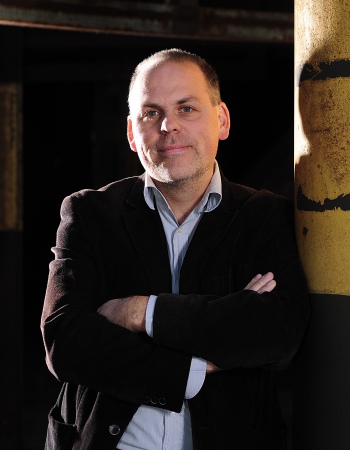
ArminLiedinger
Dr. Armin Leidinger
Communication / Presse
Telephone: +49 (0) 6898 / 9 100 151
armin.leidinger@voelklinger-huette.org
